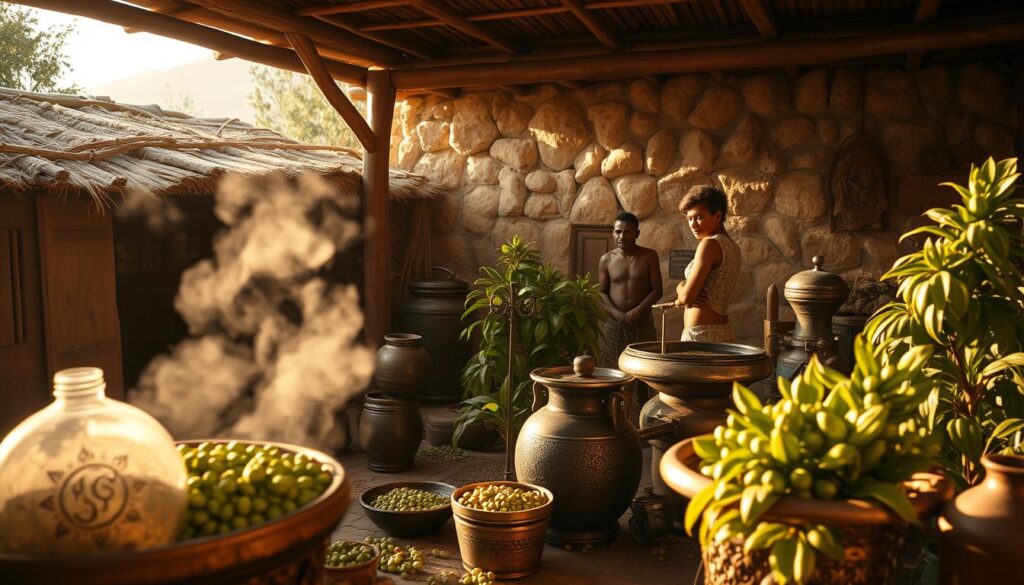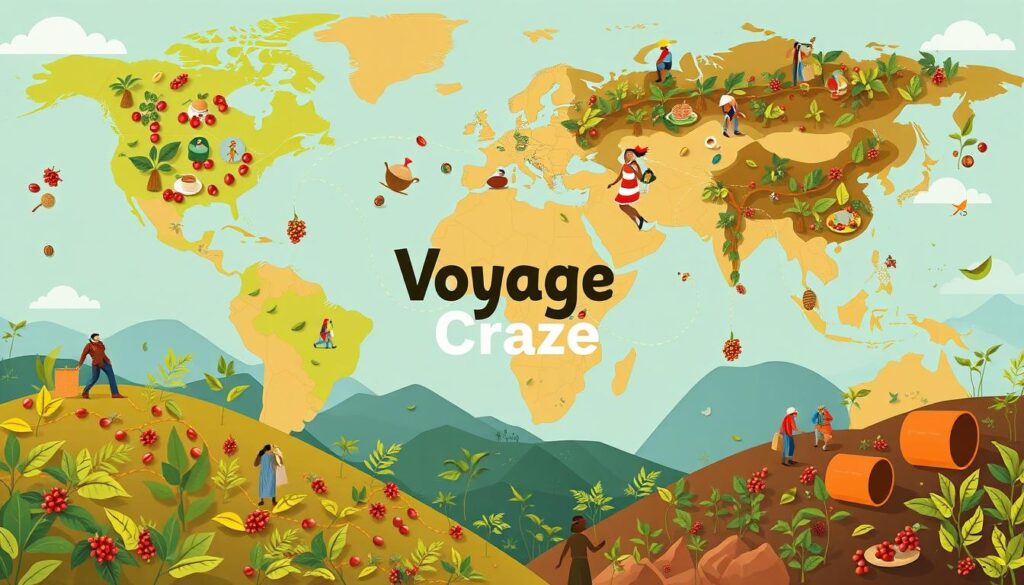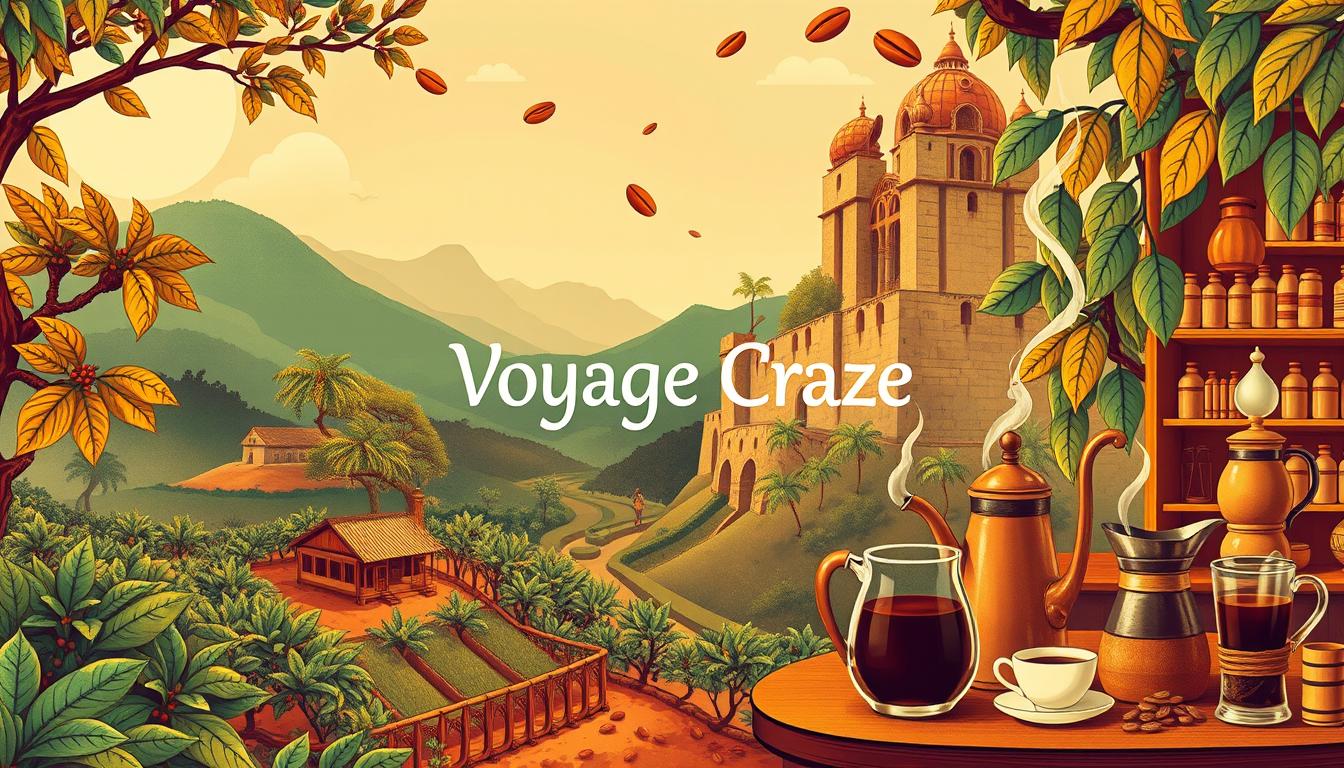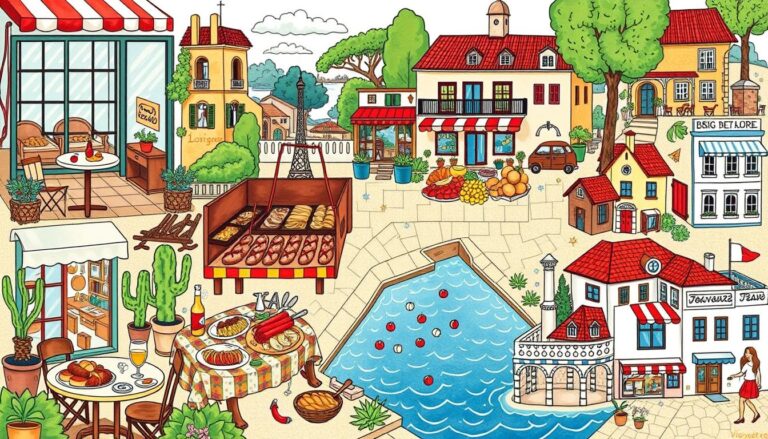Coffee is more than a drink; it’s a global phenomenon enjoyed by millions daily. Its journey from Ethiopia to the world is fascinating. Coffee’s history spans centuries and continents, deeply influencing human culture and society.
The first coffee use dates back to the 9th century in Ethiopia. Coffee spread worldwide, becoming a key part of cultures. Today, it’s one of the most popular drinks globally, with Arabica, Robusta, and Liberica being the main types.
Coffee has had a big impact on society. Coffeehouses were key spots for revolutionaries during the American Revolution. Today, major chains like Starbucks have over 30,000 locations worldwide. The industry is now focusing on eco-friendly practices, like recyclable pods and carbon-neutral roasting.
Key Takeaways
- The history of coffee spans centuries and continents, from its origins in Ethiopia to its current status as a global cultural phenomenon.
- Coffee has played a significant role in shaping human culture and society, with coffeehouses emerging as popular social venues.
- The three main types of coffee are Arabica, Robusta, and Liberica, each with its unique flavor and taste.
- Coffee’s impact on society has been significant, with coffeehouses serving as meeting points for strategizing revolutionaries during the American Revolution.
- The coffee industry is increasingly investing in eco-friendly practices, including recyclable coffee pods and carbon-neutral coffee roasters.
- The global demand for fair trade coffee, organic coffee, and direct trade relationships is rising, reflecting growing consumer awareness about sustainability.
The Origins of Coffee in Ethiopia
Coffee culture has a rich history, starting in Ethiopia around 850 AD. The story of Kaldi, a young goat herder, is famous. He noticed his goats were more energetic after eating coffee cherries.
Over time, Ethiopia became a big name in coffee worldwide. Today, it’s the 5th largest coffee producer, with most coffee staying in the country. Places like Sidama, Yirgacheffe, and Harrar are known for their top-quality beans.
Ethiopian coffee is known for its unique flavors. The dry and washed processing methods create tastes like fruity and floral. Whether you love coffee or are new to it, Ethiopian coffee is a must-try.
The Journey of Coffee to the Arab World
Coffee’s historical significance in the Arab world is quite interesting. Trade routes grew, making coffee more common. By the 15th century, it was enjoyed in Yemen, Persia, and Turkey. The Arabic name, “qahwa,” originally meant wine, showing its historical significance and roots in Yemen.
The evolution of coffee drinking in the Arab world saw coffeehouses become key spots. In cities like Constantinople and Cairo, these places were hubs for artists, intellectuals, and merchants. They were where ideas were shared and exchanged.
Trade Routes and Early Spread
Coffee reached the Arab world through trade. By 1414, it was known in Mecca. The English and Dutch East India Companies bought coffee in Mocha in the early 17th century. But, they only got a small part of Yemen’s coffee.
Coffeehouses in the Middle East
Coffeehouses in the Middle East were crucial for the region’s culture and society. The first one opened in Istanbul in 1554. Soon, Cairo had coffeehouses near the University of Azhar. These places were where intellectuals and artists met, creating a lively cultural scene.

Today, the evolution of coffee drinking still influences Arab culture. Even though Yemen’s coffee production has dropped, coffee is still a big part of Arab life. Its historical significance is still honored in the region.
The European Introduction to Coffee
Coffee’s arrival in Europe was a big deal in coffee trade history. It came through expanded trade routes. The first European coffeehouse opened in Venice in 1645. This was a key moment for the coffee industry development, as coffeehouses became centers for learning and culture.
Coffee’s Arrival in Europe
At first, Europeans were unsure about coffee. But as it became more popular, coffeehouses started popping up in big cities. These places became key spots for social and cultural events.
The Role of Coffeehouses in Society
Coffeehouses were crucial in shaping European society and culture. They were where people met to talk, share ideas, and do business. The coffee industry development grew because of these coffeehouses, spreading coffee’s popularity across the continent.
Important moments in coffee trade history include adding milk and sugar to coffee in Vienna in 1683. Also, one of the first cafés opened using leftover beans from the Ottoman Turks. These moments helped the coffee industry development in Europe, leading to today’s coffee culture.
Coffee and Colonialism
Coffee’s history is complex, tied to the exploitation of enslaved labor in the Americas. Its growth has greatly influenced local economies and communities worldwide.
The first coffee plantation in the Americas was in Martinique in 1714. By 1750, coffee trees were found on five continents, including Central and South America. This shows how quickly coffee spread.
The impact of coffee on society is clear in its effect on economies. For instance:
- Coffee is key to the GDP of many coffee-exporting countries.
- The coffee industry is worth billions, but most profits go to a few countries and companies.
- 44% of smallholder coffee farmers globally live in poverty, with about 5.5 million earning less than $3.20 a day.

The legacy of colonialism still affects the coffee industry. It’s crucial to address the impact of coffee on society. We must strive for a fair and sustainable global coffee production system.
The Evolution of Coffee Brewing Methods
Coffee brewing methods have changed a lot over the years. They have shaped how we enjoy The History of Coffee today. From old ways to new espresso machines, coffee brewing has seen a lot of new ideas.
Old methods involved soaking coffee grounds in hot water for hours. But now, methods like the Ibrik from Turkey are faster and tastier. The first coffee maker, “Mr. Biggin,” came out in 1780, and metal filters were patented in 1802. These changes made brewing coffee easier and better.
Looking at coffee brewing’s history, we see each method has its own special points. Whether it’s the deep flavor of French Press or the easy use of drip brewers, there’s something for everyone. By exploring coffee origins and brewing ways, we can really appreciate coffee’s rich and interesting world.
Some key coffee brewing methods are:
- Boiling and percolation
- Filtration
- Espresso
- French Press
- Drip brewing
These methods have not only changed how we make coffee but also coffee culture and traditions. As we keep exploring and creating in coffee, it’s key to remember the deep The History of Coffee that got us here.
Coffee’s Role in American Culture
Coffee has been a big part of American life since the American Revolution. The coffee culture in the United States has grown over time. It has been shaped by history and social changes.
Coffee first appeared in America in the late 1600s. Its popularity grew during the Boston Tea Party of 1773. This was because colonists chose to boycott tea.
Coffee has deeply influenced American society. It has changed how people interact with each other. In the early 20th century, coffee shops and diners became places where people gathered.
Today, millions of Americans start their day with a cup of coffee. Over 50% of American adults drink coffee every day.

Coffee is now a big part of American life. There are about 37,000 coffee shops in the United States. The demand for specialty coffee shops has also grown.
This shows that Americans are looking for better coffee experiences. As the coffee culture keeps growing, coffee will likely stay a big part of American life.
Globalization and Coffee Trade
Coffee is enjoyed by 2.3 billion people every day around the world. Its popularity has grown thanks to globalization. This has led to fair trade and ethical coffee sourcing.
Fair trade coffee production has seen a big jump, from 0.34% in 2004 to 0.51% in 2005. Yet, only 0.51% of coffee is fair trade. The coffee world involves many players, from farmers to those who drink it.
Some interesting facts about coffee include:
- Every year, over 7,875,180 tons of coffee are made.
- Coffee grows mainly in the tropics, especially in Latin America, Southeast Asia, and Africa.
- The move to more coffee production has caused a lot of deforestation. This hurts rainforests in places like Africa, Southeast Asia, and South America.
The coffee industry is big and affects the world economy. Companies like Starbucks have grown a lot. They went from 100 stores in 20 years to about 18,000 stores in 10 years.
Specialty Coffee Trends
The history of the coffee trade has led to many trends in the coffee world. One big trend is the rise of specialty coffee. This trend comes from the third wave coffee movement, which values high-quality, unique coffee beans and new brewing ways.
Recently, 45% of American adults tried specialty coffee in the last day. This is up 80% since 2011. This growth means more people want top-notch coffee beans and new brewing methods. The coffee industry has grown because of this, with many places focusing on specialty coffee.
Third Wave Coffee Movement
The third wave coffee movement has greatly influenced specialty coffee. It stresses the importance of quality coffee beans, direct trade, and new brewing techniques. Many specialty coffee roasters follow this, focusing on fair trade and eco-friendly farming.
Innovative Brewing Techniques
New brewing techniques have also helped specialty coffee grow. Methods like cold brew, pour-over, and espresso are getting more popular. Coffee shops and roasters are trying out new and unique ways to brew coffee. This has also led to more demand for coffee-related items, like grinders and brewing gear.
- Increased demand for sustainable coffee options
- Growing popularity of single-origin coffee
- Significant rise in searches for cold brew-related terms
The history of the coffee trade and the growth of the coffee industry are linked to specialty coffee. As more people want high-quality coffee, the industry will keep evolving. It will focus on sustainability, quality, and creative brewing methods.
The Science of Coffee
Coffee is a complex and fascinating beverage. It has a rich history and culture. The global coffee production industry is a big part of the economy. Many countries rely on coffee as a major export.
Coffee has many health benefits. It can reduce the risk of certain diseases and improve cognitive function. The chemistry of flavors in coffee is also interesting. Many factors influence the taste and aroma, like the type of bean and roast level.
- Altitude and climate
- Soil type and quality
- Coffee bean variety
- Roast level and brewing method
These factors make each cup of coffee unique and complex. As the global coffee industry grows, we’ll see new ways of producing and enjoying coffee.
Sustainability in Coffee Production
Coffee production affects the environment a lot. The industry faces many sustainability challenges. Looking into The History of Coffee and coffee origins shows us how important sustainable practices are.
Big environmental issues in coffee include deforestation, climate change, and water pollution. Many coffee producers are now using sustainable farming methods. These methods, like agroforestry and organic farming, help the environment and improve soil health.
Every day, over 2 billion cups of coffee are drunk. The global coffee industry makes over $468.2 billion a year. But, coffee production harms the environment, like destroying rainforests and wasting water. We need to use sustainable coffee production to lessen these effects.
- Agroforestry: This means growing coffee with other crops and trees. It helps biodiversity and stops soil erosion.
- Organic farming: It avoids synthetic fertilizers and pesticides. This reduces the environmental harm of coffee making.
- Integrated Pest Management (IPM): It uses different methods to manage pests. This cuts down on chemical use.
By using these practices, coffee producers can lessen their environmental impact. They can also help biodiversity and make their farms more sustainable. As consumers, we can support sustainability by choosing certified sustainable coffee.
| Practice | Benefits |
|---|---|
| Agroforestry | Promotes biodiversity, reduces soil erosion |
| Organic farming | Reduces environmental impact, improves soil health |
| Integrated Pest Management (IPM) | Reduces reliance on chemical interventions, promotes ecosystem balance |
The Future of Coffee
The world’s coffee culture is changing fast. New tech in farming and processing, plus plant-based drinks, are changing the game. This mix is set to make the coffee world both exciting and a bit uncertain.
New tech like smart sensors and drones is making farming better. Farmers use these tools to grow more coffee, fight pests, and manage their work better. This means better coffee and a greener planet. Also, coffee drinks made from plants like mushrooms and oats are becoming popular. They offer a healthy and eco-friendly choice for coffee lovers.
The future of coffee is full of ups and downs. But one thing is sure: coffee will keep being a big part of our lives. As people care more about where their coffee comes from, the industry needs to change. By using new tech and ideas, coffee makers can help keep this beloved drink alive and thriving.







